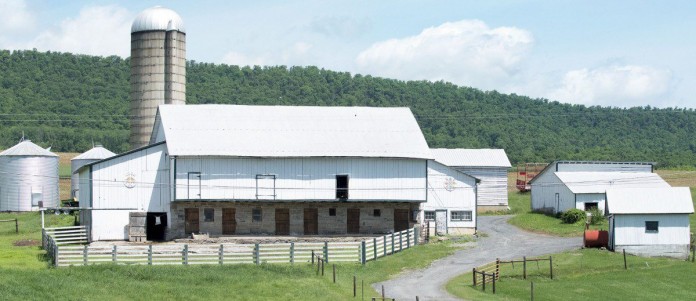UNIVERSITY PARK, Pa — The rustic beauty of Pennsylvania’s farmhouses, barns and outbuildings often strikes motorists traveling the highways that crisscross the rural heartland of the state, but few people realize the stories these buildings can tell us about the past — and maybe the future — of agriculture.
They can reveal how farm families in Pennsylvania lived and worked, as well as who settled the state, says Sally McMurry, professor of American history, Penn State.
Historic spotlight.
Handsome farmhouses and barns often literally and figuratively overshadow plainer and smaller agricultural outbuildings, but the latter structures focus a historic spotlight on the diversity and entrepreneurialism of Pennsylvania farming operations. Pennsylvania farmers required multiple outbuildings because they were involved in highly diversified farming and business operations.
“Most people will talk about the farmhouses and the barns, but one of the interesting things about Pennsylvania farms is the number of outbuildings they have,” says McMurry.
Pennsylvania farmers required multiple outbuildings because they were involved in highly diversified farming and business operations, according to McMurry.
Overseas markets for grain were important in colonial times, but this cash market was complemented by a variety of other farm products.
Spring houses, for example, supported home butter production. Farming families might churn butter and sell or trade it locally, in addition to consuming it at home, McMurry says.
Buildings like smokehouses, root cellars, workshops, maple sugar houses, potato cellars, butcher houses, granaries and poultry houses supported other aspects of diversified farming.
Throughout the 19th century Pennsylvania farms served mostly local markets with a wide variety of foods, fiber, hay and straw.
Regional influence.
Each Pennsylvania region had its distinctive signature landscapes. Pennsylvania Germans left their imprint in the east, building bank barns with distinctive forebays and living in simple unadorned houses, while “Yankee” immigrants brought their architectural customs to the Northern Tier, including the English barn and a preference for Greek Revival and Italianate house styles.
Studying farm architecture not only reveals past production patterns, but it can demonstrate the hard work people invested in farming, McMurry adds.
“For example, women did the home buttermaking; in the Philadelphia area they might make a ton of butter in a year, mostly sold in local markets,” says McMurry.
“Most farm labor came from the family; kids and adults alike worked in the barns, summer kitchens, pig sties and other outbuildings on a Pennsylvania farm.”
In central Pennsylvania, young men often farmed “on shares” for a father or uncle. In this arrangement, the son farmed the land in exchange for a share of the crop. Tenant houses and shared barns reflected this type of farming.
As agriculture modernized in the 20th century, the state’s farming landscape became more homogenized. Standardized milk houses, silos and stanchion barns replaced the smaller scale diversified farmsteads.
In a few spots, such as the Adams County fruit belt and the Lehigh County potato region, packing houses or potato cellars reflected highly localized specialties.
Labor patterns changed, too. Mechanization drastically changed family work patterns and hired labor became more important.
During and after World War II, farmers relied on thousands of African American migrant workers who traveled from Florida to northern Pennsylvania and New York for work in the potato fields and in the canneries. This is often a dark chapter in Pennsylvania agricultural history, but one that should be told, according to McMurry.
“In some places migrant workers were shamefully treated,” McMurry says.
“The NAACP and other groups called attention to the substandard conditions of the living quarters.”
Shanties and shacks that once served as housing for migrant laborers still remain on some farms.
Fading imprint.
More recently, production agriculture has put many historic farm buildings in jeopardy. Smaller historic buildings may not accommodate highly specialized large-scale farming.
Even Amish farming families, who have contributed so much to keeping land in farms, have taken an approach to buildings that is based on their religious obligations, not necessarily on the preservation of history.
“In some ways they are similar to farms of the 19th century — they’re typically small scale, family-owned farming operations,” says McMurry.
“However, even though the barns serve a horse-based operation, the Amish often have modern buildings.”
These forces, McMurry says, have brought Pennsylvania’s agricultural history under threat. Because older buildings fall into disrepair and small farms are less likely to invest in restoring aging buildings, the state is steadily losing important parts of its agricultural history.
“We have a lot more intact buildings than other states, but it’s not easy for people to preserve these buildings and they can be expensive to maintain,” says McMurry, who was a member of the Pennsylvania State Historic Preservation Board from 1997 to 2003.
According to McMurry, many preservationists believe the fabric of historic buildings in the state can be saved only through use. As the current local food movement has reinvigorated selling food and other products much closer to home, small-scale outbuildings may once again become integral to the future of Pennsylvania farming, she says.
Resource.
McMurry served for about a decade as principal investigator for a large-scale collaborative initiative, the Pennsylvania Agricultural History Project, which has created a resource that can be used by preservationists to evaluate Pennsylvania’s historic farm buildings and landscapes.
She started her career as a cultural historian while attending Cornell. The unique program at that university helped her study architecture, but from the angle of a historian.
“I was interested in being a cultural historian and Cornell had a program that was open to understanding the historical context of architecture,” says McMurry.
“I fell into agricultural history because I discovered it in Cornell’s Mann Library and I stayed in that area.” She uses the farm buildings that surround Penn State as a living laboratory for students.
“I enjoy getting students out into the field to learn about history by using buildings as primary sources,” she says. McMurry, who co-wrote “Architecture and Landscape of the Pennsylvania Germans, 1720-1920” with Nancy Van Dolsen, a historic preservation consultant and history teacher at Barton College, is finishing a book about Pennsylvania farm buildings.











